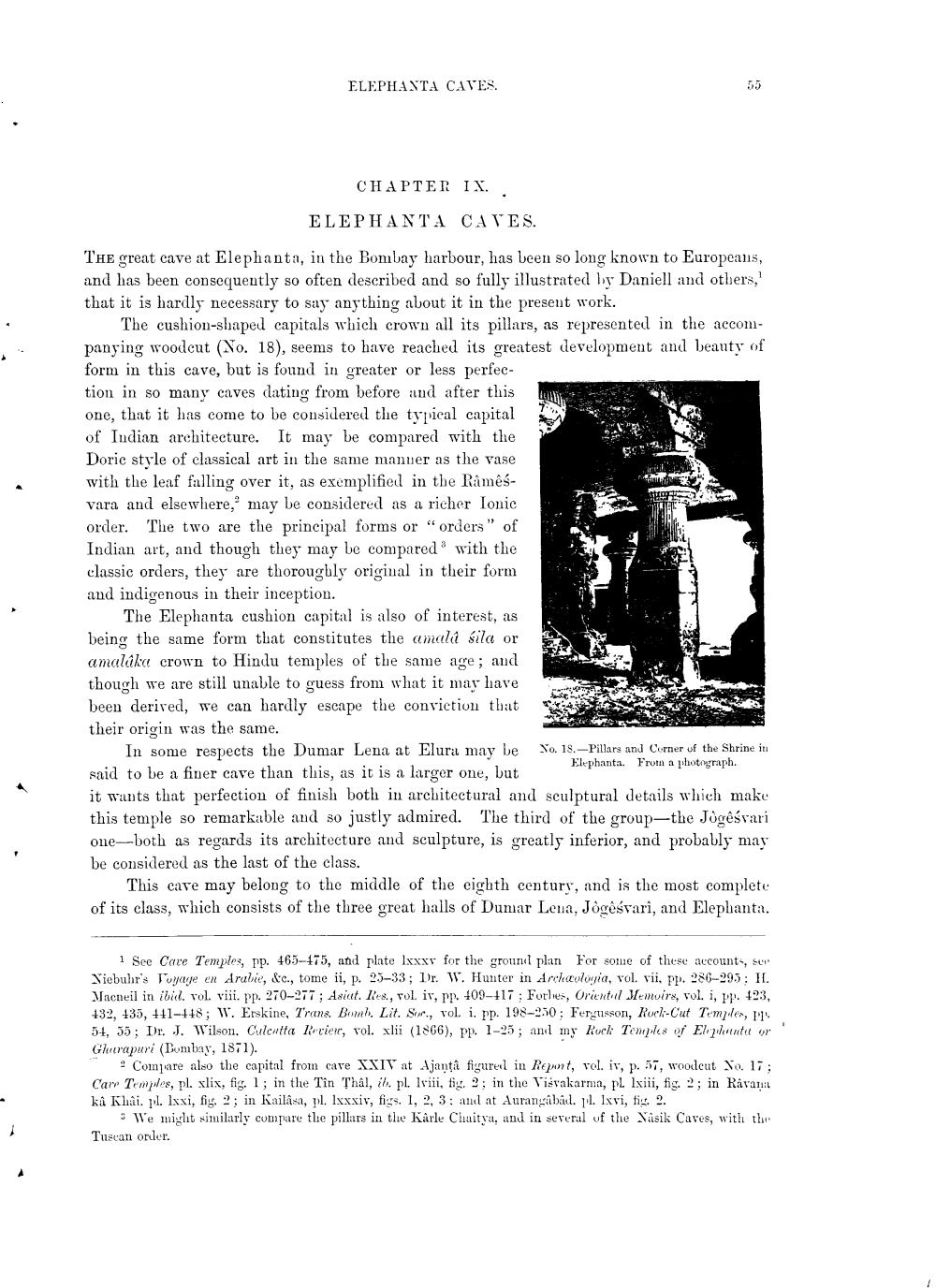________________
ELEPHANTA CAVES.
CHAPTER IX.
55
ELEPHANTA CAVES.
THE great cave at Elephants, in the Bombay harbour, has been so long known to Europeans, and has been consequently so often described and so fully illustrated by Daniell and others,' that it is hardly necessary to say anything about it in the present work.
The cushion-shaped capitals which crown all its pillars, as represented in the accompanying woodent (No. 18), seems to have reached its greatest development and beauty of form in this cave, but is found in greater or less perfection in so many caves dating from before and after this one, that it has come to be considered the typical capital of Indian architecture. It may be compared with the Doric style of classical art in the same manuer as the vase with the leaf falling over it, as exemplified in the Râmêsvara and elsewhere, may be considered as a richer Ionic order. The two are the principal forms or "orders" of Indian art, and though they may be compared with the classic orders, they are thoroughly original in their form and indigenous in their inception.
The Elephanta cushion capital is also of interest, as being the same form that constitutes the amalá sila or amalaka crown to Hindu temples of the same age; and though we are still unable to guess from what it may have been derived, we can hardly escape the conviction that their origin was the same.
In some respects the Dumar Lena at Elura may be said to be a finer cave than this, as it is a larger one, but it wants that perfection of finish both in architectural and sculptural details which make this temple so remarkable and so justly admired. The third of the group-the Jõgevari one-both as regards its architecture and sculpture, is greatly inferior, and probably may be considered as the last of the class.
No. 18.-Pillars and Corner of the Shrine in Elephanta. From a photograph.
This cave may belong to the middle of the eighth century, and is the most complete of its class, which consists of the three great halls of Dumar Lena, Jogêśvari, and Elephanta.
1 See Cave Temples, pp. 465-475, and plate lxxxv for the ground plan For some of these accounts, ser Niebuhr's Voyage en Arabie, &c., tome ii, p. 25-33; Dr. W. Hunter in Archæologia, vol. vii, pp. 286-295; H. Macneil in ibid. vol. viii. pp. 270-277; Asiat. Res., vol. iv, pp. 409-417; Forbes, Oriental Memoirs, vol. i, pp. 423, 432, 435, 441-448; W. Erskine, Trans. Bomb. Lit. Sor., vol. i. pp. 198-250; Fergusson, Rock-Cut Templer, P 54, 55; Dr. J. Wilson. Culcutta Review, vol. xlii (1866), pp. 1-25; and my Rock Temples of Elephantu or Gharapuri (Bombay, 1871).
Compare also the capital from cave XXIV at Ajantâ figured in Report, vol. iv, p. 57, woodcut No. 17; Care Temples, pl. xlix, fig. 1; in the Tin Thâl, i. pl. lviii, fig. 2; in the Visvakarma, pl. lxiii, fig. 2; in Ravana ka Khai. pl. lxxi, fig. 2; in Kailasa, pl. lxxxiv, figs. 1, 2, 3 and at Aurangabad. pl. Ixvi, fig. 2.
We might similarly compare the pillars in the Karle Chaitya, and in several of the Nasik Caves, with the Tuscan order.




